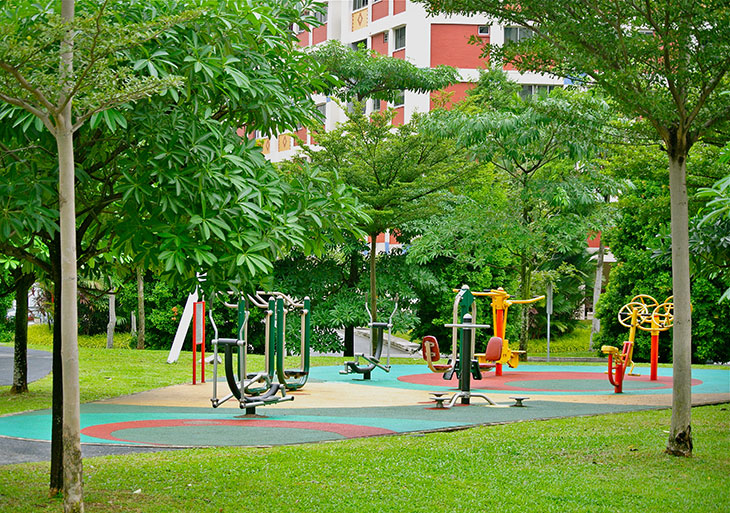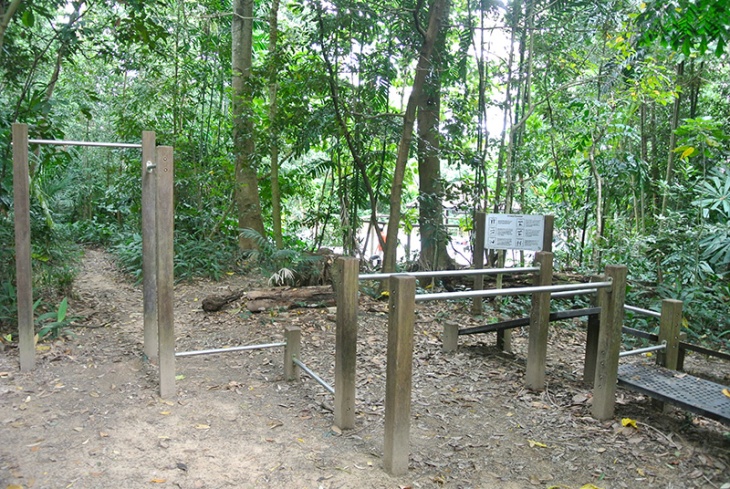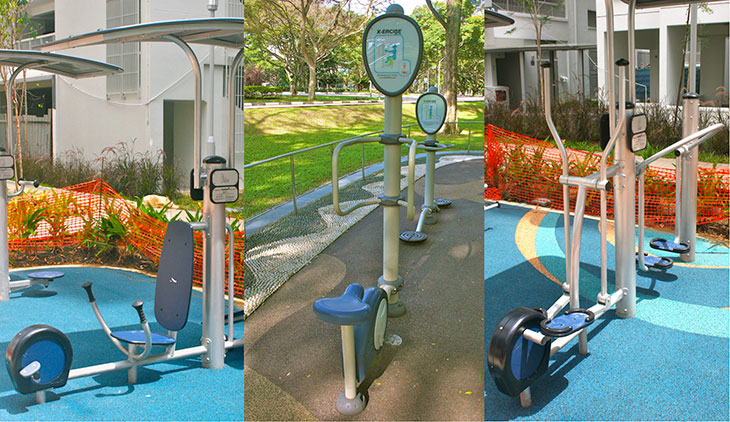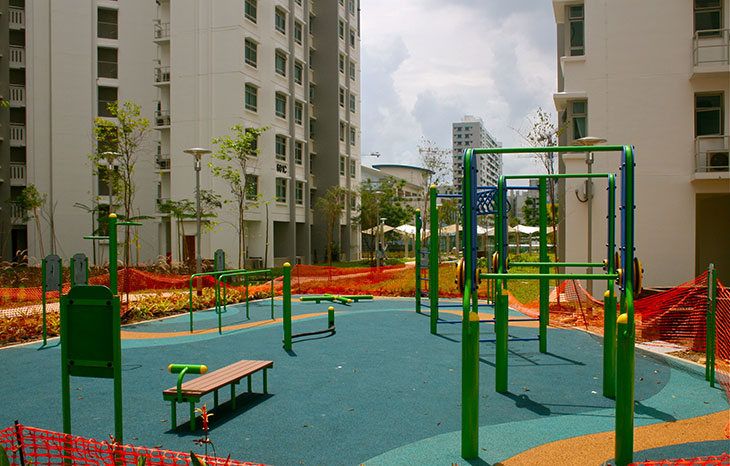Special Report:
SINGAPORE – A HIGH-DENSITY CITY WITH SPORTING CHARACTERS
Chapter 6: Outdoor Fitness Stations
The provision of ample free-of-charge outdoor gym areas is a peculiarity of Singapore’s urban design. As part of the government’s quintessential public health and social cohesion policy, these all-weather stationary fitness facilities have over the years become a permanent and omnipresent feature of the city’s public space; most notably, they are an integral part of city parks, sports complexes, park connectors, activity parks and residential HDB-public housing estates.

A pleasant workout environment in a public housing area in Bishan. Outdoor fitness zones located in such residential estates are mostly encircled by trees.

Outdoor fitness area in a public housing estate in the outer northern district of Woodlands. The integrative concept of green space and outdoor fitness zones is a notable achievement of the local urban planners.

Typical fitness stations integrated into a track and field stadium in Toa Payoh – one of the oldest districts of modern Singapore.

A lavishly spacious fitness zone located in the large Bishan-Ang Mo Kio Park.

A selection of medium- and large-sized outdoor fitness zones embedded into HDB-public housing estates across Singapore.
Singapore’s urban policy of making outdoor fitness equipment publicly accessible derived largely from the fitness trail movement, which was popularised in various developed countries in the early and mid-1970s. While, in 1978, only three outdoor fitness areas existed in the entire city of Singapore, the number has risen steeply during the 1980s and 1990s, reaching 469 by 1994. And by 2006 the overall figure of designated outdoor fitness areas amounted to a total of 1212: in that year 56% of the outdoor fitness areas were located in public housing estates and city parks alone, while the educational facilities accounted for nearly 33% of the total – according to the official raw data on local facilities.
On this note, the reader should take notice of the fact that in the past couple of decades similar outdoor gym areas have mushroomed across Chinese cities, too. It needs to be clarified, however, that Chinese policymakers have adopted Singapore’s concept of implementing outdoor gym facilities into their swelling high-rise districts. Ever since Deng Xiaoping, the former de facto leader of the People’s Republic of China, voiced his admiration for the city-state’s quality of urban development and its public housing program – among other things – during his visit to Singapore in 1978, Singaporean urban planners have taken an active role in advising Chinese policymakers on high-density city planning – a historical detail that has not received much attention among international city planning consultants and urban policy makers.
In Singapore outdoor gym zones offer a wide range of fitness equipment, varying in design, function and manufacturer. As for the aspect of functionality they are meant to improve up to four physical conditions: strength, flexibility, balance and endurance. In an attempt to provide various target groups with adequate equipment, in Singapore the composition of outdoor gym zones follows a specific pattern. For example, dip bars, pull-up bars, sit-up benches and monkey bars – which are designed for body weight-based strength tasks – are predominantly located at the track and field stadia and nearby HDB-outdoor game courts.
Across HDB-public housing estates, on the other hand, fitness stations such as leg press, lateral pull down, shoulder flexor, Tai Chi wheel, balancing beam, back massager machine and body twister are the most common options, tailored to the specific needs of older residents with rapidly declining levels of flexibility, balance and strength. In addition, elliptical cross-trainers and sky runners – which aim at improving endurance and losing body weight – are fairly popular with middle-aged female residents. Considering their proximity to housing flats and their generous provision of space between the stations, most outdoor gym areas in public housing estates clearly give the impression that they have been designed with the intention of easing accessibility to wheelchair-bound elderly residents. The city parks and park connectors, by contrast, provide fitness stations for more diverse population groups, irrespective of the residents’ performance level, age or severity of physical disability.

Parallel bar dips, one-legged squats and pull-ups are good examples of body weight-dependent, strength-enhancing tasks.

In the Bukit Timah Nature Reserve a small-sized outdoor gym area offering body weight-dependent stations is integrated into the tropical forest environment.

Flexibility and massage stations aimed at the growing proportion of older residents have become standard features of HDB-public housing estates.

Examples of stationary cardio-enhancing machines: recumbent bicycles, elliptical cross-trainer and sky runner.

The resistance of many fitness stations, such as lateral pull down, leg press or seated chest press machines, is limited by the user’s own body-weight.

In Punggol a sitting bench is installed in front of the leg and arm cycle equipment, enabling older residents with physically restricted mobility to easily switch between the two tasks.
The city-wide installation of outdoor gym facilities in public space is, in principle, a laudable urban planning policy, exemplifying the government’s aspiration to ensure equal opportunities. If adequately designed, outdoor gym areas, after all, provide people of all ages (and of various socio-economic status) with an enjoyable urban setting that can, at no cost, help boost their overall physical fitness: that is, strength, flexibility, agility, coordination and endurance (usually, no speed tasks are offered within such outdoor gym zones).
Based on qualitative observations on the ground, however, it appears that the supply of fitness stations in many HDB-estates and city parks exceeds their demand. The outdoor gym areas look rather deserted much of the time (in particular, the smaller areas consisting of only 3 to 5 stations), suggesting that the number of fitness stations per capita has presumably reached levels of oversupply. This is not to say that Singapore’s outdoor gym areas are of little value. In the early morning hours senior residents living in public housing flats sporadically utilize the easily accessible fitness equipment, while during evenings young adults favor gym areas near park connectors or HDB-game courts – which typically offer configurations that include pull-ups, push-ups, parallel bar dips, and other popular body weight dependent, strength-enhancing tasks.
It is possible that the rather moderate popularity of these outdoor gym areas is due to two factors: first, the unsuitability of the chosen locality; and second, a likely mismatch between the offered variety of stations and the users’ actual desirability levels for such stations. HDB-gym zones, for instance, are regularly sandwiched between high-rise apartment blocks, leaving users of these fitness stations with a rather unpleasant sensation of constant observation. Hence, choosing an adequate location before installing outdoor fitness equipment could be crucial to boosting utilization rates.
It is also advisable to streamline the somewhat scattered fitness stations and to put more emphasis on overall multi-functionality of outdoor gym areas. By concentrating the most popular fitness equipment in fewer, yet more compact gym zones, for instance, more residents could be encouraged to visit such areas and the utilization time of these fitness stations could be increased. By developing larger outdoor gym zones located within proximity to shower facilities and security lockers the number of users could be boosted in the city parks, too.
By the same token, some of the existing fitness stations could be replaced by more functionally suitable alternatives. Although being barely utilized, sit-up benches, for instance, take up disproportionately large parts of the current outdoor fitness areas – with up to five benches offering various inclination angles. This overcapacity aspect aside, practicing abdominal curl-up tasks on the benches’ hard surface could be a rather uncomfortable and painful experience for skinny people with naturally protruding lumbar vertebras (i.e., the skeletal structure of the lower part of the spine) and pelvic bones.

Although arrays of sit-up benches are regularly integrated into outdoor fitness areas, they are barely used (such as this area in the Bedok Reservoir Park).

A rare example of gym equipment with adjustable dumbbells in an HDB-residential estate in Bukit Panjang.

A rather unique fitness station concept in the hilly Kent Ridge Park in the inner-city district of Queenstown.

The man-made beach in the East Coast Park contains several fitness stations; their utilization rate remains rather low, however.

In some residential areas the deserted looking outdoor fitness zones have been turned into playgrounds for school kids.

A victim of the high-density concept? In Punggol – Singapore’s latest major urban planning area and the government’s poster child of the 21st century residential living concept – outdoor fitness stations are sandwiched between the newly built high-density, high-rise residential flats.
Installing large numbers of the most suitable and most efficient equipment is another suggestion that deserves to be considered. To optimize the overall physical fitness effects, local users should be offered stations that ensure high-quality returns, that is, tasks that deliver the greatest physical and health benefits relative to the individual’s invested time; in other words, providing stations and tasks that demonstrate the highest efficiency ratings. For instance, many standard outdoor fitness machines – such as lateral pull down, leg press or seated chest press – lack a resistance variability function, and the user’s own body-weight serves as the only available resistance when executing force-enhancing tasks on these body weight-dependent machines; i.e., the resistance can not be adjusted to the personal strength levels due to absent load increment options. As a result, the neuromuscular system gets accustomed to the inflexible intensity levels (usually within a few weeks of practicing), suppressing substantial gains in strength and muscle mass. In short, the users largely fail to achieve their desired strength outcomes.
Although resistance-adjustable equipment – such as machines with weight stack, cable machines or hydraulic equipment – could, in principle, be installed in selected outdoor gym zones, this would certainly come along with higher product and maintenance costs. As it is highly unlikely that such cost-intensive modifications will occur any time soon, outdoor fitness areas should, in their present form, be viewed more like a complementary option that physically active residents can add to their main sports activities. Proximity to other key sporting amenities, especially running trails and basketball courts, should therefore be considered in any future urban design.
To the planners’ credit, beautification of the city’s outdoor gym areas appears to have been a top priority. Many fitness zones offer pleasant and inspiring settings, with many areas being painted in bright colors and being surrounded by greenery. Perhaps one of the finest, and most popular, outdoor gym areas is the fitness park located in the western part of the East Coast Park. With its compactness, its notable diversification of equipment and the provision of outdoor shower facilities, it ticks off most of the essential aspects of a comprehensive outdoor fitness zone. Certainly, its location is of advantage, too: for one thing, it is located next to a car park area; for another, this gym zone is linked to a formidable 10km running and cycling trail.

A good example of a multifunctional outdoor fitness zone located in the western part of the East Coast Park.

Task descriptions are regularly provided at various outdoor fitness areas.

Many free-of-charge outdoor fitness stations are installed in publicly accessible areas, such as public housing estates and public parks. In contrast, subsidized public indoor gym facilities only account for a small proportion of the overall supply.
In all, the creation of publicly accessible outdoor fitness zones across the entire city of Singapore is a laudable urban policy that reflects the rapidly emerging global era of personal investment in health and well-being. In the world of fierce city competition in the areas of liveability and human capital, this is a huge untapped potential for Singapore’s city image; it is plausible that sporting and recreation facilities will increasingly become a deciding factor for prospective residents. Hence, Singapore should start acknowledging the significance of its outdoor gym concept and take credit for its impressive public policy. It certainly is worth telling the world about it.
>> READ next chapter “Urban running cultivation”
